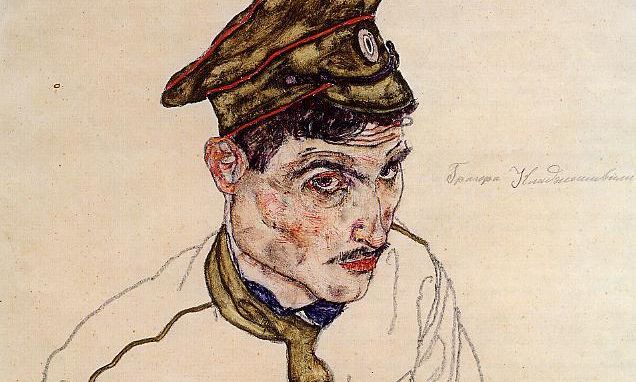Egon Schiele, Russian War Prisoner, 1916 Manhattan District Attorney's Office
The Art Institute of Chicago (AIC) has come under fire from the Manhattan District Attorney’s office for engaging in alleged “willful blindness” regarding Nazi-looted work in its collection.
Investigators attempting to seize a drawing by Egon Schiele from the museum’s holdings filed a 160-page motion on 23 February that accuses the AIC of ignoring fraudulent provenance in its acquisition of the piece. The drawing in question, Russian War Prisoner, was purchased by the museum in 1966 and is one of several works by the artist sought by the descendants of Fritz Grünbaum, a Jewish cabaret artist and art collector from Vienna murdered by Nazis. Investigators determined that the work was worth upwards of $1.2m; the museum acquired it for $5,500 (roughly $53,000 in today's dollars), The New York Times reported.
“We have done extensive research on the provenance history of this work and are confident in our lawful ownership of the piece,” a representative for the AIC said in a statement. “If we had this work unlawfully, we would return it, but that is not the case here.”
The recent court filing refutes this argument, alleging that the museum's “failure” to vet the work “undercuts any arguments that AIC were truly good-faith purchasers.”
Much of the filings’ contents have been cited in previous civil cases by Grünbaum's heirs and resulted in seven museums agreeing to turn over works to the Manhattan DA’s Antiquities Trafficking Unit. The AIC has argued that the heirs came forward too late to lay claim to this particular drawing, underscoring a federal court’s previous ruling and insisting that the piece could have been inherited by Grünbaum’s sister-in-law, who the museum alleges sold the Schieles to a Swiss dealer in the 1950s.
In over 100 separate exhibits, investigators contend that the dealer, Eberhard Kornfeld, altered provenance documents and forged signatures long after the pieces came into his possession. “There is one person in this case who doctored” documents, “and always did so in pencil — Eberhard Kornfeld”, the chief of the Antiquities Trafficking Unit, Matthew Bogdanos, noted in the court filing.
According to investigators, while no one can be certain of how Kornfeld obtained the Schieles, there is a strong likelihood that it was through Nazi-linked liaisons. Prosecutors say that they have located inventory records establishing the work’s presence in an Austrian Nazi-controlled storehouse in 1938—after Grünbaum was sent to Dachau, where he was killed in 1941. Prosecutors have also found documents showing that his sister-in-law, Mathilde Lukacs, fled the country while the drawing was in the storage facility, proving that she could not have sold it to Kornfeld.
The AIC first argued that it holds legitimate title to the work in a 2011 ruling, in which the judge characterised Kornfeld’s account as “credible”. In a second New York case that resolved in November of 2023, the court awarded ownership of the drawing to the AIC, ruling that the Grünbaum heirs had waited too long to make a claim. Despite these decisions, the New York State Supreme Court declared in 2018 that Grünbaum had never sold or surrendered any works in his collection before his death—these were looted by Nazis, and his heirs were the rightful owners.
In a statement, representatives for the AIC said, “Federal court has explicitly ruled that the Grünbaums’ Schiele art collection was ‘not looted’ and ‘remained in the Grünbaum family’s possession’ and was sold by Fritz Grünbaum’s sister-in-law Mathilde Lukacs in 1956.”
The AIC represents a rare holdout in the Nazi-restitution conversation—the Carnegie Museums of Pittsburgh, Allen Memorial Art Museum at Oberlin College and New York's Museum of Modern Art and Morgan Library & Museum, along with the estate of the collector Serge Sabarsky and cosmetics mogus Ronald S. Lauder, have all agreed to return works to the Grünbaum family.

